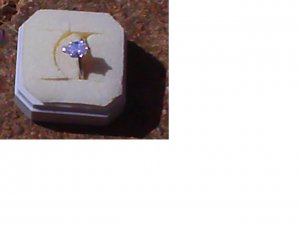FB.
Brilliant_Rock
- Joined
- Jun 29, 2009
- Messages
- 764
It's no surprise that I've recently been analysing strongly fluorescent diamonds in some detail.
The general beliefs seem to be:
In the colourless grades (D-F), more than faint fluorescence is bad.
In the slightly tinted grades (I-J and possibly slightly lower colours), some fluorescence is beneficial because the colour is complementary to blue and makes the diamond appear whiter.
I plan to put a torpedo into the latter idea, with my own observations and some reasoning.
In strong light, almost all well-cut diamonds reflect so much light that they "face-up" colourless, due to the very strong light return. Even I-J can look colourless.
Even casual glances at the side-views of I/J stones don't show much (if any) colour in strong light.
Therefore, I don't see that fluorescence adds anything to the colour grade in bright light.
In low light, I seem to notice diamond body colour much more easily - even face-up. I can usually tell a H from a D when mounted and possibly distinguish G from D.
This is where the lower colours would most need the "complementary" blue colour of the fluorescence to offset the yellow body colour. But diamonds don't fluoresce in most low-light situations.
Therefore, although fluorescence would improve the colour grade in low light, the lack of light means no fluorescence and no ability to improve the colour.
As I see it; only in mediocre-cut-grades, of slightly-tinted-colour diamonds, in bright light, would fluorescence manage to make an improvement to the perceived colour.
I'm not saying that fluorescence is bad. I'm just saying that I can't see how it is as beneficial to low colour stones as the price premiums suggest - except at the point of sale, where a jeweller can pass-off an uncertificated fluorescent J as perhaps an H.
Regards
FB
The general beliefs seem to be:
In the colourless grades (D-F), more than faint fluorescence is bad.
In the slightly tinted grades (I-J and possibly slightly lower colours), some fluorescence is beneficial because the colour is complementary to blue and makes the diamond appear whiter.
I plan to put a torpedo into the latter idea, with my own observations and some reasoning.
In strong light, almost all well-cut diamonds reflect so much light that they "face-up" colourless, due to the very strong light return. Even I-J can look colourless.
Even casual glances at the side-views of I/J stones don't show much (if any) colour in strong light.
Therefore, I don't see that fluorescence adds anything to the colour grade in bright light.
In low light, I seem to notice diamond body colour much more easily - even face-up. I can usually tell a H from a D when mounted and possibly distinguish G from D.
This is where the lower colours would most need the "complementary" blue colour of the fluorescence to offset the yellow body colour. But diamonds don't fluoresce in most low-light situations.
Therefore, although fluorescence would improve the colour grade in low light, the lack of light means no fluorescence and no ability to improve the colour.
As I see it; only in mediocre-cut-grades, of slightly-tinted-colour diamonds, in bright light, would fluorescence manage to make an improvement to the perceived colour.
I'm not saying that fluorescence is bad. I'm just saying that I can't see how it is as beneficial to low colour stones as the price premiums suggest - except at the point of sale, where a jeweller can pass-off an uncertificated fluorescent J as perhaps an H.
Regards
FB










300x240.png)